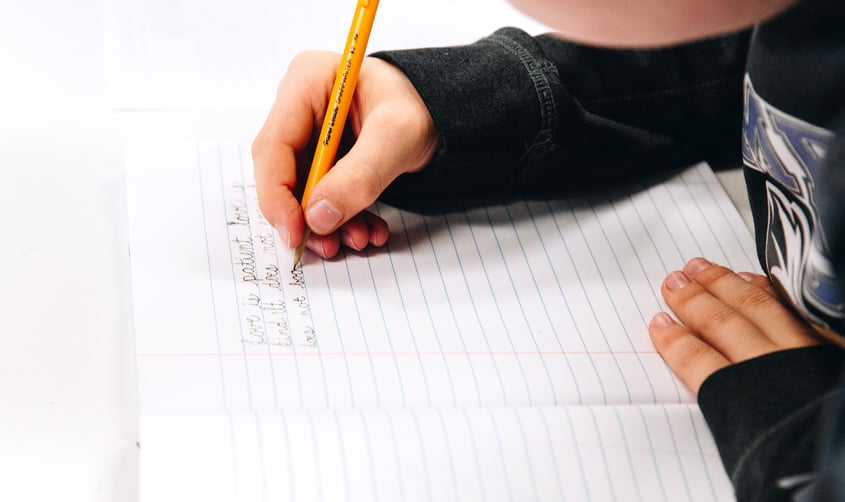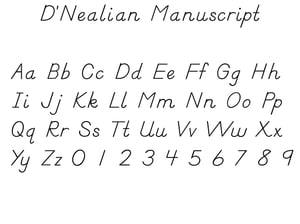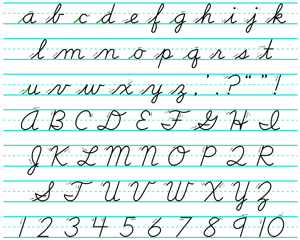
Why Are Schools Cursing Cursive?
With the shift towards more technology in the classroom, it should come as no surprise that the majority of states—more than 40—no longer require handwriting instruction, especially cursive handwriting.
According to a report from 11Alive news, Georgia requires instruction of cursive writing, typically beginning in grade three. However, since cursive writing is not assessed at the state level and is left to local determination for assessment, in most Georgia schools, cursive writing is no longer being taught.
There are a myriad of reasons why schools should reconsider cursive in their curriculum since cursive writing strengthens numerous academic skills, including visual-motor coordination, visual synthesis, visual perception, visual memory, spatial relationship, spelling, reading, and focus.
CURSIVE WRITING BUILDS IMPORTANT MUSCLES
 Developing fine and gross motor skills is important for students as they mature. When they learn cursive, students learn to write in a more complicated way than manuscript printing. Cursive writing activates different hand muscles and a different part of the brain. The flow of cursive is more like drawing than writing.
Developing fine and gross motor skills is important for students as they mature. When they learn cursive, students learn to write in a more complicated way than manuscript printing. Cursive writing activates different hand muscles and a different part of the brain. The flow of cursive is more like drawing than writing.
Cursive is usually taught around the age of seven or eight, a crucial time for developing more robust motor skills. According to Candace Meyer, CEO of Minds-in-Motion, Inc., “Cursive handwriting naturally develops sensory skills. Through repetition, children begin to understand how much force needs to be applied to pencil and paper, the positioning of the pencil to paper at the correct angle, and motor planning to form each letter in fluid motion from left to right. This physical and spatial awareness allows them to write, but more importantly, build the neural foundation of sensory skills needed for a myriad of everyday tasks, such as buttoning, fastening, tying shoes, picking up objects, copying words from blackboards, and, most importantly, reading.”
CURSIVE WRITING increases neural pathways
Recent research indicates that writing in cursive is better for the brain because when students write with this technique, neurons fire in different ways than manuscript printing. When young brains encounter new information, they create new neural pathways that, with practice, become permanently imprinted.
A 2012 Indiana University study found that reading centers of the brain were stimulated when five-year-olds first learned to write. Writing on the blank page was much more stimulating for these reading centers of the brain than simply tracing or typing letters.
Cursive writing stimulates both sides of the brain, according to William Klemm, senior professor of neuroscience at Texas A&M University. And, handwriting expert Jeanette Farmer says, “Handwriting has a physiological/psychological link in the brain. This link is so strong that nothing else done in the classroom can begin to compare with the powerful impact that repetitively manipulating the thumb and fingers over time has on the young brain.”

CURSIVE WRITING LEADS TO FASTER NOTE-TAKING AND PROMOTES RETENTION OF LEARNING
 Manuscript printing is cumbersome and takes longer than cursive writing, creating the potential for falling behind during lectures and lessons. Typing has the propensity to lead to word-for-word copying of lectures versus the internal processing and short-hand that occurs with handwritten notes. “Students who take notes on a laptop tend to transcribe lectures verbatim, while students who hand-write notes process information and reframe it in their own words, reinforcing learning,” say researchers Pam Mueller and Daniel Oppenheimer.
Manuscript printing is cumbersome and takes longer than cursive writing, creating the potential for falling behind during lectures and lessons. Typing has the propensity to lead to word-for-word copying of lectures versus the internal processing and short-hand that occurs with handwritten notes. “Students who take notes on a laptop tend to transcribe lectures verbatim, while students who hand-write notes process information and reframe it in their own words, reinforcing learning,” say researchers Pam Mueller and Daniel Oppenheimer.
Recent research shows that students who take notes in cursive versus using a laptop keyboard retain more information. According to a New York Times report, students who wrote in cursive for the SAT scored higher than those who wrote in print. Iris Hatfield, author of New American Cursive, says students have better recall of course material when transcribing in cursive versus print or digital. Given the current integration of digital learning, students should receive instruction in both cursive writing and keyboarding/typing skills.
CURSIVE WRITING BENEFITS ALL STUDENTS
Students with learning differences benefit from multi-sensory instructional methods. Exposing all students to the differing visual characteristics of cursive letters, along with the repetition of learning to write for a second time (that is, cursive in addition to print), gives students a new way to look at writing.
Teaching cursive is advantageous for students with language-learning issues. Various printed letters look similar or make mirror images of one another, and cursive writing helps alleviate this issue. In her research review, Diane Montgomery asserts that cursive may be helpful for students with dyslexia and dysgraphia.
Iris Hatfield says that print can be more difficult to learn because of the start and stop motion of pencil to paper, whereas cursive writing flows with more distinctive-looking letter shapes than print.
CURSIVE WRITING PREVENTS LANGUAGE ILLITERACY
In academic reading, students are exposed to documents and letters written in cursive. Iris Hatfield states, “When individuals cannot read cursive, they are cursively illiterate in their own language.” Students will not be able to read historical documents or family notes from previous generations if they are not taught cursive. It should not become a lost art.

THE PROGRESSION OF WRITING AT MPCS
 At Mount Paran Christian School, faculty believe in a developmental approach to teaching writing. Preschool students begin with manuscript printing when they are developmentally ready, usually starting in PreK4. When students enter Kindergarten at MPCS, they receive year-long formal instruction in D’Nealian print, which continues into the first-grade year. D’Nealian print was developed by Donald Thurber in 1978 as a slanted style of handwriting in English that helps prepare children for the transition from print to cursive.
At Mount Paran Christian School, faculty believe in a developmental approach to teaching writing. Preschool students begin with manuscript printing when they are developmentally ready, usually starting in PreK4. When students enter Kindergarten at MPCS, they receive year-long formal instruction in D’Nealian print, which continues into the first-grade year. D’Nealian print was developed by Donald Thurber in 1978 as a slanted style of handwriting in English that helps prepare children for the transition from print to cursive.
D’Nealian print leads to instruction in D’Nealian cursive at MPCS, beginning in the spring semester of second grade and continuing through third grade. Based on research-backed reasoning for its inclusion in the curriculum, cursive writing has been taught at MPCS for many years.
 Iris Hatfield says that cursive writing helps build confidence. “Cursive handwriting is complex and is inherently associated with the development of fine-motor skills and hand-eye coordination,” she says. “Learning cursive prompts children to also develop self-discipline, which is a useful skill in all areas of life. The ability to master the skill of writing clearly and fluidly improves the students’ confidence to communicate freely with the written word. Handwriting is a vital life skill” — even for newer generations.
Iris Hatfield says that cursive writing helps build confidence. “Cursive handwriting is complex and is inherently associated with the development of fine-motor skills and hand-eye coordination,” she says. “Learning cursive prompts children to also develop self-discipline, which is a useful skill in all areas of life. The ability to master the skill of writing clearly and fluidly improves the students’ confidence to communicate freely with the written word. Handwriting is a vital life skill” — even for newer generations.
Katy Rogers is the Assistant Head of Lower School at Mount Paran Christian School. Amber Irizarry, Communications Content Specialist, assisted with this article.
To learn more about the innovative academic curriculum at Mount Paran Christian School, click here.
Sources:
https://www.weareteachers.com/cursive-instruction-benefits/
https://www.familyeducation.com/school/penmanship/6-benefits-learning-handwriting-school
- christian school
- christ-centered
- mount paran christian school
- high school
- early childhood education
- intellegence
- elementary school
- kindergarten readiness
- cognative thinking
- brain development
- intellectual learning
- learning differences,
- challenging education
- learning disabilities
- academic rigor
- innovative learning
- hands-on learning
- christian education
- why christian education
- why christian school
- lower school
- challenging curriculum
- innovation
- innovating
- innovative education
- cobb county private school
- academic excellence
- best academics in cobb county
- alumni success
- servant leadership
- best of Cobb private school
- best private school Cobb county
- Winner best of Cobb
- Early-childhood education trends
- metacognition
- rigorous high school Georgia
- best christian school georgia
- MPCS alumni
- high school rigor GA
- pursuing excellence independent school
- parenting elementary kids
- Best of Cobb Best Private School
- cursive
- handwriting
- D'Nealian
- Best Teacher in Cobb county

WingTips
Welcome to WingTips, a Mount Paran Christian School Blog. The MPCS Blog features many independent school contributors and thought-leaders.
Subscribe Here!
Recent Posts
Learn More About MPCS
Recommended Series
PRIVATE SCHOOL PRIMER:
- How School Choice Programs Increase Educational Opportunities for Families
- 5 Tips for Making the Middle to High School Transition
- What Families Should Expect
- 2 Most Important Things to Consider When Choosing a Preschool
- 4 Benefits of Choosing a K-12 School for Life
- 3 Reasons Why I Believe in Christian Schools
- 7 Tips for Affording a Private School Education
- 4 Reasons We Chose Mount Paran Christian School
- How to Choose the Best Private School for Your Family
- 4 Methods to Meet Every Learner Where They Are
PARENTEd. TALKS:
- Helping Students Boost Their Brain Capacity for Success
- Teaching Children Fiscal Responsibility
- Tips for Parents to Help Teens Avoid Drugs and Alcohol
- Excelling in the Midst of Adversity
- 3 Tips for Navigating the Hidden Dangers of Social Media
- The Blessing of a B Minus
- Real Talk for Moms
COLLEGE SERIES:
- Finding the Right Fit - An Individualized Approach to College Counseling
- ParentEd.: Here’s What You Need to Know About College Admissions
- To Save or Not to Save: 529 Plans are the Question
- College Admissions: A Marathon, Not a Sprint
FROM THE TEACHER’S DESK:
- The Importance of Play
- What Families Should Expect
- Play is Learning Through the Arts
- 4 Tips to Capture the Minds of Your Students
CHRISTIAN LIFE:
- What is a Covenant School?
- Seeing Through a New Lens: A Biblical Worldview
- Faith and Intellect as One
- Philosophy of Belonging: 4 Tips for Fostering a Diverse Culture
- Innovation in Education: Teaching Cultural Awareness
- A Call to Brotherhood: Martin Luther King Jr.’s Wisdom for Today
- CommUNITY: How Do We Love One Another?
- Campaign for CommUNITY
- How to Raise Empathetic Children in Today’s Culture
- Imageo Dei: Why Diversity Matters
- Praying for Their Future
Providing academic excellence in a Christ-centered environment, Mount Paran Christian School unites with home and church to prepare servant-leaders to honor God, love others, and walk in Truth.


